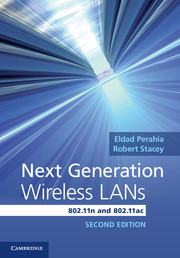Foreword
Published online by Cambridge University Press: 05 June 2013
Summary
Foreword
The first version of the 802.11 standard was ratified in 1997 after seven long years of development. However, initial adoption of this new technology was slow, partly because of the low penetration of devices that needed the “freedom of wireless.”
The real opportunity for 802.11 came with the increased popularity of laptop computers just a few years later. This popularity brought a rapidly growing user base wanting network connectivity not only while connected to an Ethernet cable at home or at work, but also in between: in hotels, airports, conference centers, restaurants, parks, etc. 802.11 provided a cheap and easy way to make laptop mobility a reality for anyone who wanted it.
However, technology by itself is rarely sufficient, particularly in the networking space, where interoperability of devices from multiple vendors is almost always the key to market success. Having been formed as WECA in 1999, the Wi-Fi Alliance was ready to provide certification of multi-vendor interoperability.
With the right technology from the IEEE 802.11 Working Group, certified interoperability from the Wi-Fi Alliance, and a real market need based on a growing installed base of laptops, the conditions were ripe for the Wi-Fi market to take off, and indeed it did. By 2007 virtually every new laptop contains Wi-Fi as standard equipment. More importantly, and unlike some other “successful” wireless technologies, many of these devices are used regularly. With this wide use came a growing understanding of the power of cheap, easy-to-deploy, and easy-to-manage interoperable Wi-Fi networks.
- Type
- Chapter
- Information
- Next Generation Wireless LANs802.11n and 802.11ac, pp. xv - xviiiPublisher: Cambridge University PressPrint publication year: 2013



